Geraniums easy to keep. They come from southern Africa. They blossom in spring, then disappear in bulbs or succulent trunks for a long summer rest. Unusual corollas and very strange leaves to reduce transpiration.
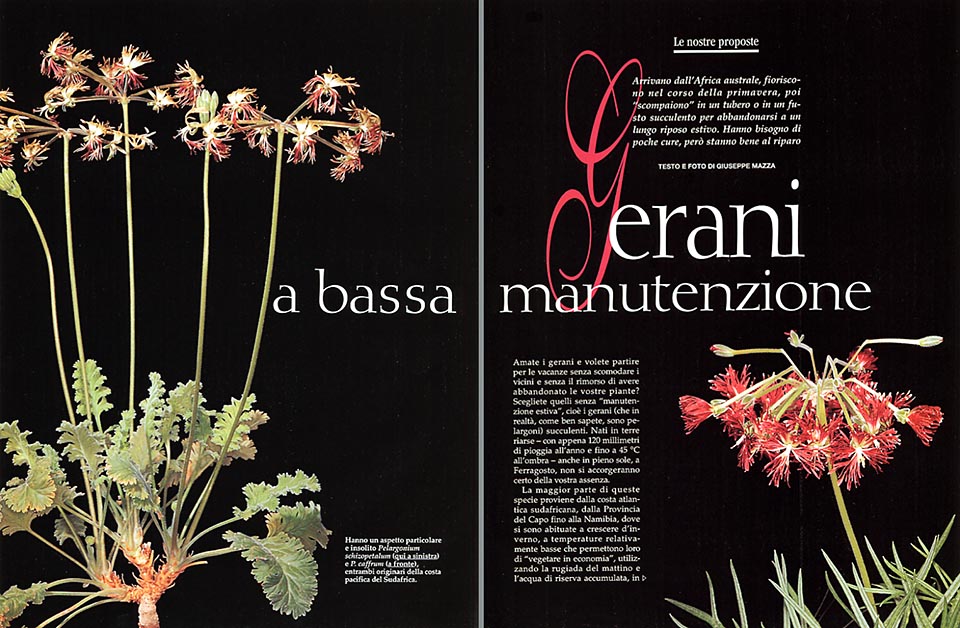
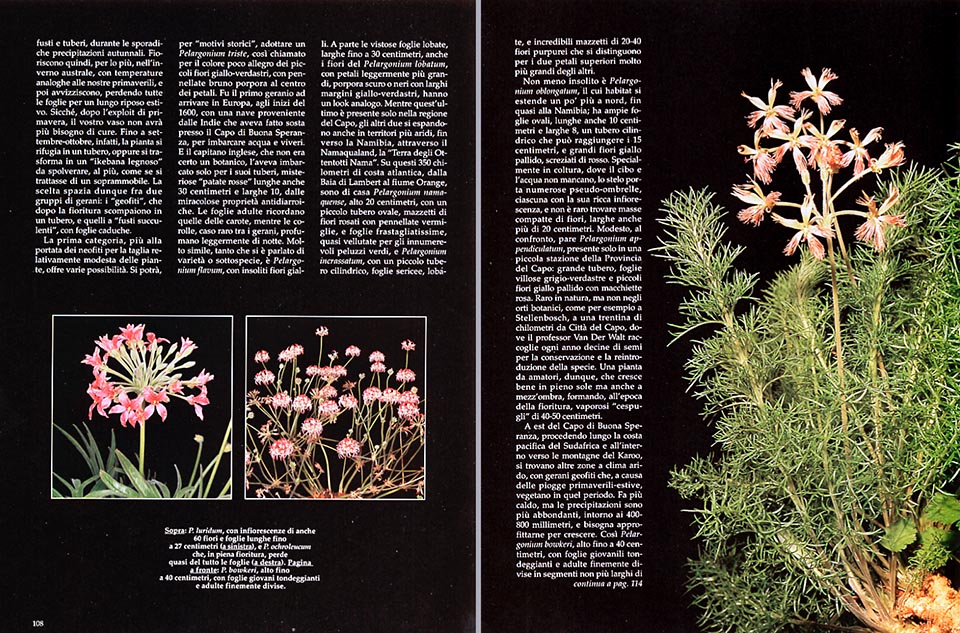
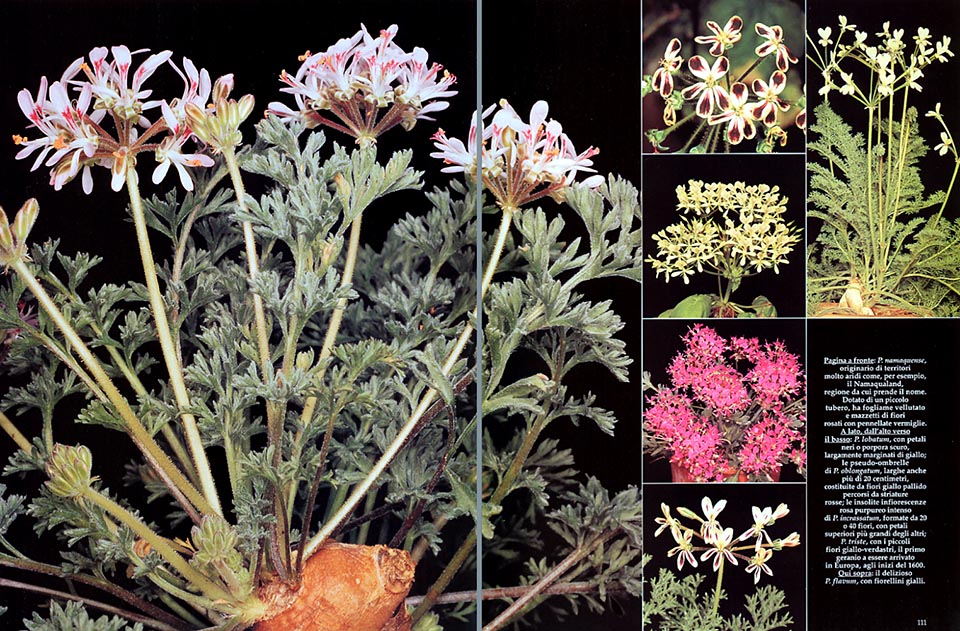
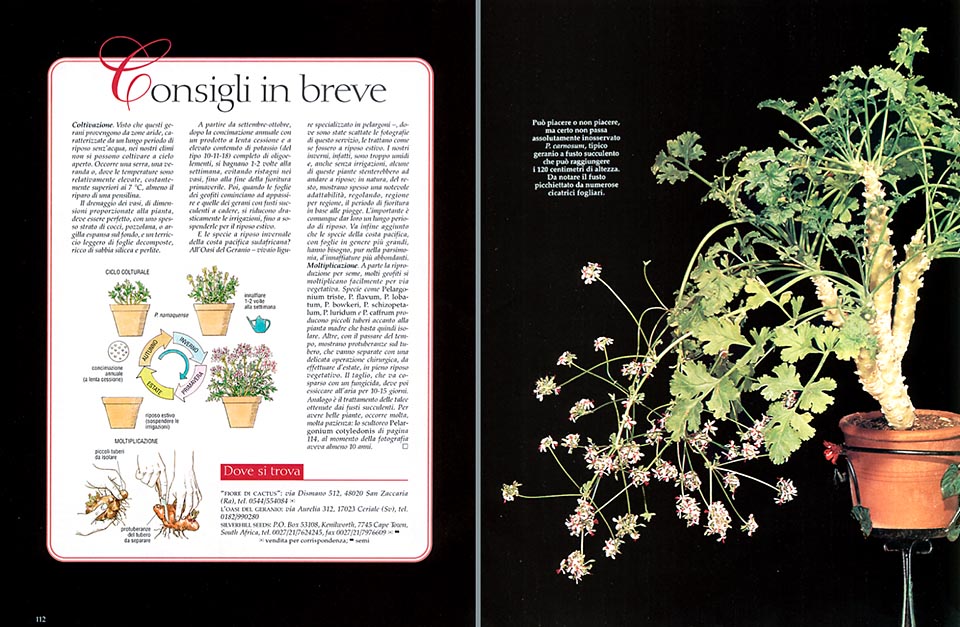
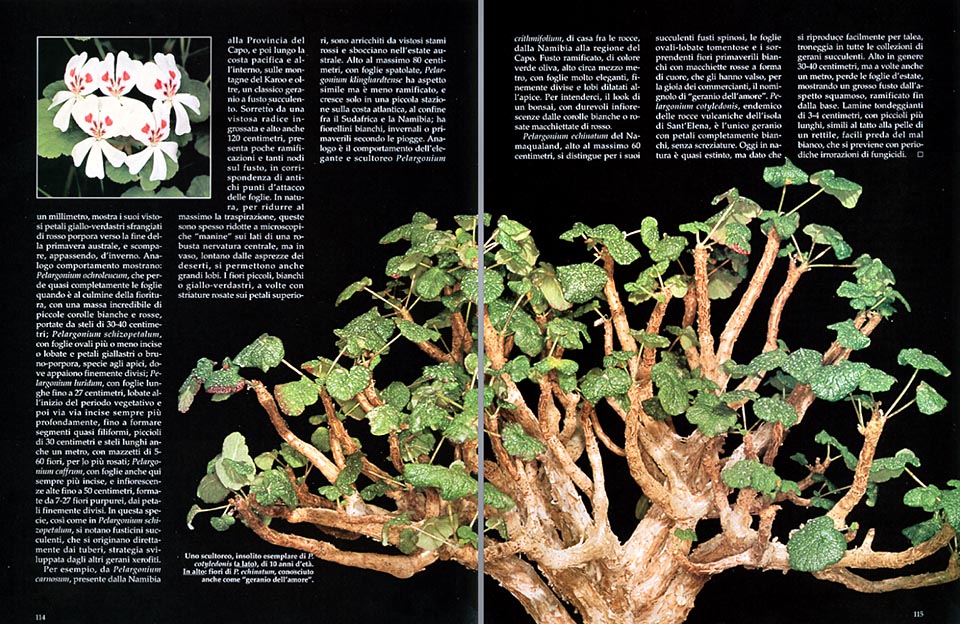

Texto © Giuseppe Mazza

English translation by Mario Beltramini
Do you love geraniums, and you want to go on vacations, for all the summer, without disturbing your neighbours, or with the remorse of having abandoned your plants? Choose those which do not need any “summer maintenance”, then, the succulent geraniums.
As they were born in arid lands, with only 120 mm of rain per year, and 45°C in the shade, even if left in full sun, by mid-August, they will not even notice your absence.
Most of these species come from the Atlantic South African coast, from the Cape Province up to Namibia, where they have become accustomed to grow up in winter, with relatively low temperatures, which allow to vegetate “economically”, with the morning dew and the spare water, accumulated in stems and tubers during the sporadic autumn precipitations.
They bloom mainly during the austral winter, with temperatures analogous to ours in springtime, and then wither, loosing all the leaves, for a long summer rest.
Which means that, after the spring display, your pot will not need any more attention. Until September-October, the plant shelters in a tuber, or transforms in a “woody ikebana”, which is, at most, to be dusted like a knick-knack.
The choice ranges, therefore, between two groups of geraniums: the “geophytes”, which, after blooming, disappear in a tuber, and those with “succulent stems”, deciduous.
The first category, more convenient to neophytes, because of the relatively modest size of the plants, offers various possibilities.
We can, for “historical reasons”, adopt a Pelargonium triste, so called for the not very merry colour of the small flowers, yellow greenish, with brown-purple touches in the centre. This was the first geranium to reach Europe, by the beginning of 1600, with a vessel coming from the Indies, which has made a call near the Capr of Good Hope, to load water and provisions, and the English master, who, by sure, was not a botanist, had taken it on board only for its tubers, mysterious red potatoes, long even 30 cm and 10 wide, with portentous anti-diarrhoeic properties. The adult leaves recall those of the carrots, and the corollas, rare thing among the geraniums, have a light scent during the night.
Very similar, and in fact they have been talking of variety or subspecies, is the Pelargonium flavum, with unusual yellow flowers, and apart the showy lobed leaves, wide up to 30 cm, also the flowers of the Pelargonium lobatum, with slightly larger petals, deep-purple or black, with wide yellow greenish margins, have an analogous look.
Whilst this last one is present only in the Cape Province, the other two spread also in areas more arid, up to Namibia, through the Namaqualand, the “land of the Hottentots Nama”, 350 Km. of Atlantic coast from Lambert Bay to the Orange River, where are located the Pelargonium namaquense, 20 cm tall, with a small oval tuber, small bunches of pink flowers, with vermilion touches, and very indented leaves, almost velvety due to the countless small green hair, and the Pelargonium incrassatum, with a small cylindrical tuber, silky leaves, lobed, and incredible small bunches of 20-40 purple flowers, which are remarkable due to the two upper petals, much bigger than the others.
Not less unusual, is the Pelargonium oblungatum, with a habitat spreading even more northwards, until almost Namibia. Wide oval leaves, long even 10 cm and 8 wide, a cylindrical tuber which can reach the 15 cm, and great yellow, pale flowers variegated of red. Particularly if cultivated, when the nourishment and water do not miss, the stem carries numerous pseudo-umbrellas, each one with its rich inflorescence; and it is not uncommon, like in the photo, to find compact masses of flowers, wide even more than 20 cm.
In comparison, the Pelargonium appendiculatum, present only in a small station of the Cape Province, seems modest. Large tuber, grey greenish and villous leaves, and small flowers, pale yellow with pink small dots. Rare in the wild, but not in the botanical orchards, like in Stellenbosch, where Professor Van Der Walt collects every year many seeds for the conservation and the reintroduction of the species. A plant for lovers, therefore, which grows well in full sun, but also in mid-shade, forming, at the time of flowering, vaporous “bushes” of 40-50 cm.
East of the Cape of Good Hope, proceeding along the Pacific coast of South Africa, and in the hinterland towards the mountains of the Kaeoo, we find other areas with dry climate, with geophyte geraniums connected to progressively spring- summer rains. It is warmer, but the precipitations are more abundant, around 400-800 mm., and they have to take advantage of this, for growing up.
So, the Pelargonium bowkeri, tall up to 40 cm, with roundish juvenile leaves (see photo), very different from the adult ones, finely divided in segments not wider than 1 mm., shows its yellow-greenish showy petals, laciniated of purple-red, by the end of the austral spring, and disappears, withering, in winter.
Analogous is the behaviour of the Pelargonium ochroleucum, which loses almost completely the leaves when it is at the top of the flowering, with an incredible mass of small white and red corollas, carried by stems of 30-40 cm; of the Pelargonium schizopetalum, with oval leaves more or less carved or lobed, similar stems, and yellowish or brown-purple petals, particularly at the apices, where they look finely divided; of the Pelargonium luridum, with leaves long up to 27 cm, lobed at the beginning of the vegetative period, ans then with incisions always deeper till to form almost filiform segments, petioles of 30 cm, and stems, long even one metre, with small bunches of 5-60 flowers, mostly pinky; or of the Pelargonium caffrum, with leaves also in this case always more carved, and inflorescences tall up to 50 cm, with 7-27 purple flowers with the petals finely divided.
In this species, and in the Pelargonium schizopetalum, we notice at the exit of the tubers also some small succulent stems, the strategy developed by other xerophyte geraniums.
The Pelargonium carnosum, present from Namibia to the Cape Province, and then along the Pacific coast, and in the hinterland, on the mountains of the Karoo, and further away, is a classical geranium with succulent stem, supported by a showy enlarged root, reaches also the 120 cm. Few ramifications and many nodes on the stem in correspondence of the old points of junction of the leaves.
In the wile, in order to reduce the transpiration to the maximum, these are often reduced to microscopical “small hands”, on the sides of a robust central nervation; but in pot, far away from the roughness of the deserts, they allowed themselves also great lobes.
The flowers, small, white or yellow-greenish, with possible pink striae on the upper petals, are enriched by showy red stamens and blossom during the austral summer.
Tall, at the most, 80 cm, with spatulate leaves, the Pelargonium klinghardtense has a similar appearance, less ramified, and grows up only in a small station on the Atlantic coast at the boundary between South Africa and Namibia, with white small flowers, winter or spring-like, depending on the rains.
And analogous is the behaviour of the elegant Pelargonium crithmifolium, familiar between the rocks, on a more ample area, from Namibia to the region of the Cape. Sculptural ramified stem, green olive, tall about half a metre, with leaves very elegant, finely divided and lobes dilated at the apex. The look of a bonsai, with lasting inflorescences upwards, and corollas white or pink with small red dots.
The Pelargonium echinatum of Namaqualand, tall the most 60 cm, distinguishes itself for its thorny succulent stems, the leaves oval-lobed and tomentose, and the surprising white spring flowers, with heart-shaped small red dots, which have deserved it, for the joy of the dealers, the nickname of “Geranium of love”.
The Pelargonium cotyledonis, endemic on the rocks of St. Helena island, is the only geranium with completely, without variegations, white petals. Nowadays, in the wild, it’s almost extinct, but seen that it reproduces easily by cutting, is prominent, like a bonsai, in all the collections of succulent geraniums. Tall, generally, 30-40 cm, but even one metre, loses the leaves in summer, showing a big stem with a scaly appearance, ramified since from the base. Roundish laminae of 3-4 cm, with larger petioles, similar, to the touch, to the skin of a reptile, but easy prey of the oidium, which is wise to prevent with periodical sprinklings of fungicides.
CULTIVATION
As the succulent geraniums come all from arid areas, with a long period of rest without water, they cannot be cultivated in open air in our climates. A greenhouse, or a veranda are needed, or, where the temperatures are rather high, and never decrease under the 7°C, at least at the shelter of a roof.
The drainage of the pots, proportionate to the plant, must be perfect, with a thick layer of fragments, pozzolana, or small balls of expanse clay on the bottom, and a light mould of decomposed leaves, rich of siliceous sand and perlite.
Starting from Seprember-October, after the annual manuring, rich of potassium, with a produce with slow cession, of the type 10-11-18 with oligo-elements, are to be watered 1-2 times a week, avoiding stagnations in the pots, till the end of the spring flowering.
Then, when the leaves of the geophytes begin to wither, and those of the succulent stems to fall, we have to drastically reduce the irrigations till to interrupt them for the long summer rest.
And the species in winter rest of the Pacific South African coast?
At the Oasis of the Geranium, where these photos have been taken, they treat them as if they were in summer rest.
Besides, our winters are too wet, and even without water, some of these plants would be hardly able to retire; and in the wild they often display a remarkable adaptability, regulating, depending on the location, the flowering period on the rains.
The important thing, however, is to give them a long period of rest.
Finally, we have to add that the species of the Pacific coast, with leaves generally bigger, need, even if parsimoniously, more abundant watering.
MULTIPLICATION
Apart the reproduction by seed, many geophytes multiply easily by vegetative way.
Species such as the Pelargonium triste, flavum, lobatum, bowkeri, schizopetalum, luridum and caffrum, produce small tubers close to the mother plant, and, so, it is sufficient to isolate them.
Other, with the time, display protuberances on the tuber, ans it is necessary to separate them with a delicate surgical intervention, to be done in summer, in full vegetative rest.
The incision must be strewn with a fungicide, and then has to dry up, in open air, for 10-15 days.
Similar is the treatment of the cuttings obtained from the succulent stems. And, in order to get nice plants, much, much, patience is necessary. For a specimen of Pelargonium crithmifolium ‘Pink’, like the one shown, six years are required, and at the time of the photo the sculptural Pelargonium cotyledonis of the Oasis of the Geranium, was at least 10 years old.
GARDENIA – 1998
→ To appreciate the biodiversity within the GERANIACEAE family please click here.
